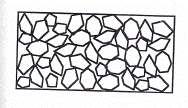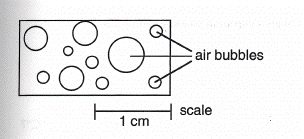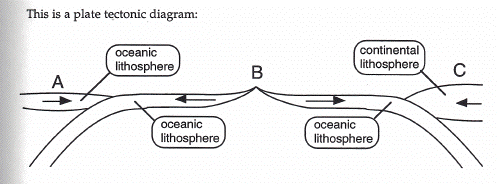- The rate of cooling of a magma or lava is reflected by the ________ of the rock.
mineralogy
texture
color
density
- The temperature (at least a minimum estimate) from which the melt cooled is reflected by the _________ of the rock.
mineralogy
texture
color
density
- Where would you expect to find the largest crystals in a lava flow?
near the top surface of the flow
in the center of the flow
near the bottom of the flow
the crystals would have the same grain size throughout the flow
- According to Bowen's reaction series, which of the following pairs of phases are likely to be incompatible?
quartz and alkali feldspar
Ca-Plagioclase and olivine
quartz and olivine
Na-plagioclase and amphibole
- The last mineral (assuming that the composition is appropriate) to crystallize from a magma is:
plagioclase
olivine
quartz
pyroxene
- The fine grained (aphanatic) equivalent of a granite is a:
rhyolite
gabbro
andesite
basalt

Grains are alkali feldspar and quartz. The length of the figure is about 2 cm.
- The diagram above most likely represents a ___________
extrusive igneous rock
intrusive igneous rock
clastic sedimentary rock
chemical sedimentary rock
- The coarse grained equivalent of a basalt is a:
rhyolite
gabbro
andesite
basalt
- Describe the plate tectonic settings where you would expect to find granitic/rhyolitic rocks:
subduction zone
continent/continent collision
spreading center
transform boundary
- Describe the plate tectonic settings where you would expect to find andesites:
subduction zone
continent/continent collision
spreading center
transform boundary
- Describe the plate tectonic settings where you would expect to find basaltic rocks:
subduction zone
continent/continent collision
spreading center
transform boundary
- Which should offer the least resistance to flow - a basaltic lava, an andesitic liquid or a rhyolitic liquid?
basalt
andesite
rhyolite
- Which is more likely, a granite dike, a diorite dike or a gabbro dike?
granite
diorite
gabbro
- Which of the following minerals might be found in a granite dike?
amphibole
muscovite
biotite
all of these
- Crater Lake, Oregon, is a lake within a:
sill
crater
caldera
volcanic neck
- Residents at the base of which one of the following would face the greatest
danger of a nuee ardente?
shield volcano
cinder cone
geyser
stratovolcano
- The continental crust is most like _______________.
granite
rhyolite
basalt
gabbro
- The oceanic crust is most like _______________.
granite
rhyolite
basalt
gabbro
- What type of volcanic rock contains a large number of cavities (bubbles) that form when gases escape from the molten rock?
granite
obsidian
pumice
basalt
- What is the effect of water on melting (assuming the rock does not contain any hydrous minerals)?
water raises the melting temperature of rock
water lowers the melting temperature of a rock
water neither raises nor lowers the melting temperature
- During crystallization of a melt plagioclase become richer in __________ .
potassium
sodium
calcium
krypton
- At about what temperature do olivine and Ca-rich plagioclase crystallize from a magma?
500 degrees C
1000 degrees C
1500 degrees C
2000 degrees C
- Which of the following is a concordant intrusive rock?
dike
sill
stock
batholith
- What type of igneous rock would contain 10 mm long plagioclase crystals surrounded by 0.5 mm long crystals?
porphyry
obsidian
phaneritic
aphanitic
- Which of the following pairs of intrusive and extrusive rocks have the same chemical composition?
granite and andesite
diorite and basalt
gabbro and basalt
gabbro and rhyolite
- Which of the following best describes a granite?
a light-colored, fine-grained igneous rock rich in silica
a light-colored, fine-grained igneous rock poor in silica
a light-colored, coarse-grained igneous rock rich in silica
a light-colored, coarse-grained igneous rock poor in silica
- Which of the following best describes a basalt?
a dark-colored, fine-grained igneous rock rich in silica
a dark-colored, fine-grained igneous rock poor in silica
a dark-colored, coarse-grained igneous rock rich in silica
a dark-colored, coarse-grained igneous rock poor in silica
- Most igneous rocks contain ___________SiO2 by weight.
less than 40%
between 40% and 70%
between 70% and 90%
greater than 90%
- Which of the following minerals is the most abundant mineral in ultramafic rocks?
amphibole
olivine
sodium plagioclase
quartz
- Which of the following statements about mafic rocks is true?
mafic rocks are richer in silica than felsic rocks
mafic rocks crystallize at higher temperatures than felsic rocks
mafic rocks are more viscous than felsic rocks
mafic rocks tend to be lighter in color than felsic rocks.
- Which of the following igneous rocks crystallizes near the Earth's surface?
basalt
gabbro
diorite
granite
- What is the approximate silica content of a granite?
20%
50%
70%
100%
- Which of these minerals is commonly found in both mafic and felsic rocks?
quartz
alkali feldspar
plagioclase feldspar
olivine
- Which of the following is NOT an extrusive igneous rock?
basalt
andesite
obsidian
granite
- Felsic => Intermediate => =>Mafic
Which of the following properties increases in the direction of the arrows in the sentence above?
melting temperature
potassium content
silica content
viscosity
- What type of magma forms at mid-ocean ridges?
basalt
andesite
ultramafic
granite
- A porphyritic igneous rock contains phenocrysts of olivine and calcium-rich plagioclase in an aphanitic groundmass. This is a __________?
andesite porphyry
basalt porphyry
gabbro porphyry
rhyolite porphyry
- A porphyritic igneous rock contains phenocrysts of olivine and calcium-rich plagioclase in an phaneritic groundmass. This is a __________?
andesite porphyry
basalt porphyry
gabbro porphyry
rhyolite porphyry
- What is the dominant rock type on most of the Hawaiian Islands?
basalt
andesite
ultramafic
granite
- What is the dominant rock type at the center of the Sierra Nevada Mountains?
basalt
andesite
ultramafic
granite
- What is the effect of water on melting?
water raises the melting temperature of a rock
water lowers the melting temperature of a rock
water does not change the melting temperature of a rock
this depends on how much water is present

- Which of the following scenarios would lead to melting of Albite plus Water?
raise the Pressure (P)
raise the Temperature (T)
either raise the Pressure (P) or raise the Temperature (T)
decrease either the Temperature (T) or Pressure (P)
- During crystallization of a magma the plagioclase feldspar __________.
is replaced by quartz
is replaced by pyroxene
becomes richer in calcium
becomes richer in sodium
- Which mineral is not part of the discontinuous reaction series?
plagioclase
olivine
pyroxene
amphibole
- At about what temperature do olivine and calcium-rich plagioclase crystallize from a melt? (answers are in degrees centigrade)
500
1000
1500
2000
- Which of the following minerals crystallizes first from a basaltic magma?
quartz
biotite
pyroxene
olivine
- How does a magma make space for itself in order to rise through the crust?
by wedging open the overlying rock
by breaking off large blocks that sink into the magma chamber
by melting the surrounding rocks
all of these
- How can a sill be distinguished from a lava flow?
a sill is generally coarser-grained than a lava flow
the rocks above and below a sill will show evidence of heating but only the rocks below a lava flow will show evidence of heating
sills generally do not have vesicles; lava flows generally have vesicles
all of these
- Which of the following is not a volcanic arc that overlies a subduction zone?
Aleutian Islands
Hawaiian Islands
Cascade Range
Japanese Islands
- What type of silicate minerals on the discontinuous side of the reaction series crystallize at the highest temperatures?
isolated tetrahedral
single chain
sheet
framework
- As a magma changes from mafic to felsic, which of the following elements decreases?
sodium
potassium
silicon
iron
- Which of the following statements is false?
mafic magmas are more viscous than felsic magmas
mafic magmas are hotter than felsic magmas
mafic magmas contain more calcium than felsic magmas
mafic magmas contain less silicon than felsic magmas
- Which of the following properties does not depend on the chemical composition of an igneous rock?
grain size
melting temperature
mineralogy
viscosity
- Compared to felsic magmas, mafic magmas are relatively enriched in:
calcium
iron
magnesium
all of the above
- A glassy texture indicates:
very rapid cooling
slow cooling
slow followed by rapid cooling
none of the above
- Pyroclastic rocks form by:
a lava cooling on the surface of the Earth
violent, explosive volcanic eruption
a magma cooling slowing in the subsurface
two phases of cooling, one fast and one slow
- The presence of phenocrysts in an igneous rocks indicate:
a lava cooling on the surface of the Earth
violent, explosive volcanic eruption
a magma cooling slowing in the subsurface
two phases of cooling, one fast and one slow
- Vesicles in an igneous rock form from:
escaping gases
phenocrysts settle to the bottom of the magma chamber
falling ash
all of the above
- The discontinuous branch of Bowen's reaction series consists of minerals with ________ structures.
isolated tetrahedra
single chains
double chains
all of the above
- Batholiths are associated with:
plateau basalts
oceanic islands
folded mountains
all of the above

- Which of the following rock types is depicted in the diagram above?
basalt
rhyolite
gabbro
diorite

- Which of the following rock types is depicted in the diagram above?
felsic
intermediate
mafic
ultramafic

- In the basalt sample depicted above, the vesicles (small spherical cavities) most likely formed
by ___________.
the escape of gas bubbles dissolved in the lave during eruption
the weathering and erosion of olivine crystals after the eruption
air bubbles entrained in the flow during the eruption
vaporization during underwater eruption

- What mineral occurs in box I of Bowen's Reaction Series (above)
amphibole
Ca-rich plagioclase
olivine
quartz
- What mineral occurs at point II of Bowen's Reaction Series (above)
Na-rich plagioclase
Ca-rich plagioclase
olivine
quartz
- What mineral occurs in box III of Bowen's Reaction Series (above)
Na-rich plagioclase
muscovite
olivine
quartz

- Which of the following volcanic chains formed at a tectonic setting similar to "A"?
Aleutian Islands
Andes Mountains
Cascade Range
Hawaiian Islands
- What type of lava is most likely to erupt at tectonic setting "B"?
andesitic
basaltic
rhyolitic
none of the above
- Which of the following volcanoes formed at a tectonic setting similar to "C"?
Hekla, Iceland
Mauna Loa
Mount Pelee, Martinique
Mount St. Helens